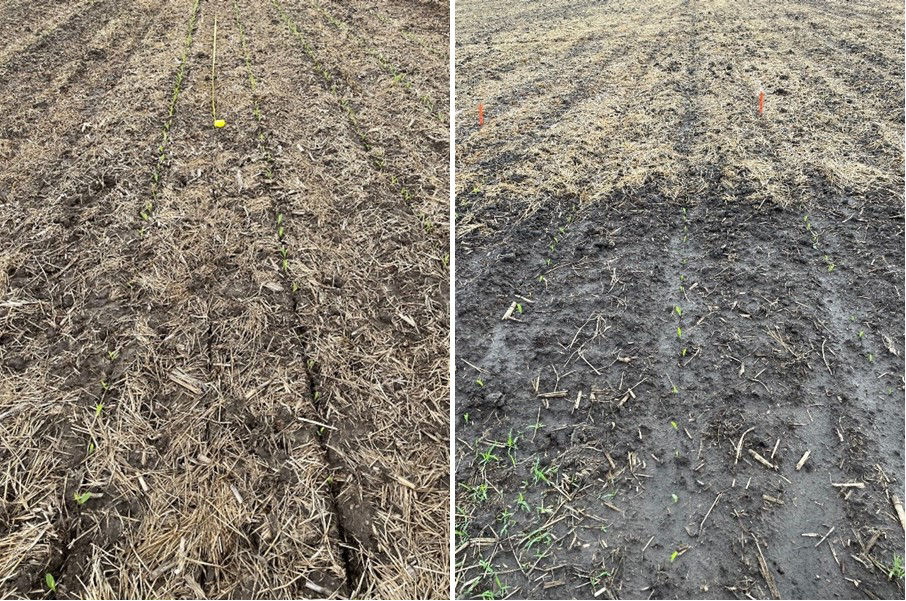Managing the Cover Crop Ahead of Corn Planting
November 15, 2024
Proper cover crop management prior to corn planting is critical to a successful corn crop. The reasons for using a cover crop include reduced soil erosion, improved soil quality (i.e. organic matter, nutrient cycling - green manure), reduction in soil surface compaction, and weed suppression. The cover crop species and its establishment and growth often determine the most effective termination and/or management practices before planting a corn crop.
A few key factors for managing or terminating include selected method, timing, and weather for that cover crop species and field. Some of the common and effective termination methods include herbicides, tillage, mowing or cutting (with possible harvest), and using a species that winter kills or has a short life cycle.
Some common concerns with cover crops that possibly result in poor corn establishment include, higher residue levels and crop interference, soil moisture, soil temperature, fertility, and possible increase in disease and insect infestations. These concerns can often be managed with earlier cover crop termination, harvesting, tillage, starter fertilizer, planter equipment adjustments, and other management practices.
In the past few years, I have experienced issues which can lead to poor corn seedling establishment and/or later corn performance issues. These issues include fields that are too dry or too wet which can affect seedling establishment. Drought conditions may lead to the cover crops using up the moisture in the planting seed depth zone, their root mass interfering with seed furrow closure, and possibly slower residue decomposition. With very wet springs, there can be high residue growth, possibly slower decomposition, poor termination and regrowth, seed furrow sidewall compaction, soil clumping, and poor seed furrow closure (Figure 1). Important considerations for herbicide applications to terminate a cover crop include herbicide selections and rates, application timing (less than 2 to 4 weeks prior to planting, time of day) and weather (cool temperature, rainy spring, and drought).

One experience in 2024 involved no-till planting into a cover crop that was terminated late. Manure was applied after a light rain which led to wet soils that were above field capacity. This led to sidewall compaction during planting and shallow compaction from field traffic. In another example, the manure was tilled under and then followed with vertical tillage by large equipment which resulted in compaction and a shallow tillage pan-layer. As a result, root restriction and nutrient deficiency symptoms occurred.
A starter fertilizer that includes nitrogen (N) may be beneficial with high-residue cover crops (i.e. small grains) because soil N may be tied up with residue decomposition. The applied N is then readily available for the corn crop regardless of planting method (tilled or no-till).
With high cover crop residue, there is a higher potential for insect infestations from true armyworm, black cutworm, seedcorn maggot, and wireworm. Also, there is a higher potential for seedling diseases such as Fusarium root rot and Pythium. To help reduce these risks, consideration should be given to earlier cover crop termination, use of starter fertilizer, and use of seed treatments.
There are resources and experienced people available for a deeper dive on cover crop management practices ahead of corn planting. I recommend small scale testing to help determine which management practices work best for a farming operation. Financial assistance for using cover crops may be available from government programs such as the Environmental Quality Incentives Program (EQIP) and Conservation Stewardship Program (CSP) and corporate programs such as the Bayer Crop Science Carbon Program, ForGround by Bayer. Government and university sites for additional cover crop information may include:
Channel Agronomist
John Kennicker
Sources
Sustainable Agriculture Research and Education (SARE).https://www.sare.org/resources
Natural Resources Conservation Service. United States Department of Agriculture (USDA). https://www.nrcs.usda.gov/programs-initiatives
Agricultural Research Service. United States Department of Agriculture (USDA). https://www.ars.usda.gov/research/publications/find-a-publication/
MSU Extension Cover Crops. Michigan State University. https://www.canr.msu.edu/cover_crops/
Cover crops. University of Minnesota Extension. https://extension.umn.edu/soil-and-water/cover-crops
Cover crop. Integrated Crop Management. Iowa State University. https://crops.extension.iastate.edu/crops/covercrops
Cover crops. Integrated Pest and Crop Management. University of Wisconsin. https://ipcm.wisc.edu/covercrops/
Web sites verified 10/11/24. 1110_452201
You may also like...
Here are some articles that may also be of interest to you